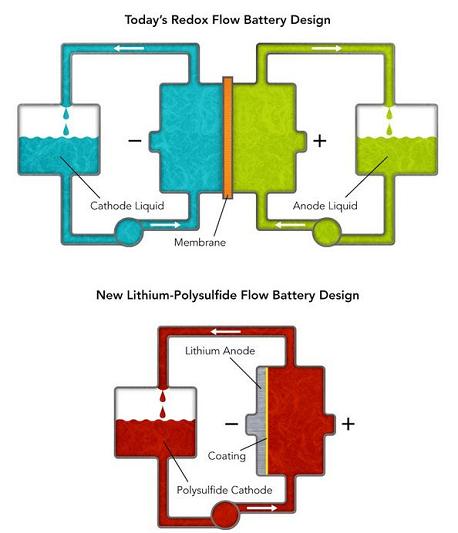
Yi Cui is an associate professor of materials science and engineering and a member of the Stanford Institute for Materials and Energy Sciences, a SLAC/Stanford joint institute. (Photo: Matt Beardsley/SLAC)
A low-cost, long-life “flow” battery could let wind and solar energy become major suppliers to the electrical grid. Researchers from the U.S. Department of Energy’s (DOE) SLAC National Accelerator Laboratory and Stanford University assisted in the design. Research was led by Yi Cui, a Stanford associate professor and member of the Stanford Institute for Materials and Energy Sciences.
Their new flow battery uses a simplified, less-expensive design than other batteries, which may improve its scalability and cost-effectiveness. In laboratory tests, it also demonstrated excellent energy-storage performance through the equivalent of more than 5 ½ years of daily charge and discharge cycles. The result was reported in the journal Energy & Environmental Science.

The diagrams compare Stanford/SLAC’s new lithium-polysulfide flow battery design with conventional “redox” flow batteries. The new flow battery uses only one tank and pump and a simple coating instead of an expensive membrane to separate the anode and cathode. (Drawing: Greg Stewart/SLAC)
Going forward, Cui’s group plans to make a laboratory-scale system to optimize its energy storage process and identify potential engineering issues. It also plans to start discussions with potential hosts for a full-scale field-demonstration unit. Argonne National Laboratory assisted with SLAC as a major partner.
“This important early result points to the value of mobilizing top researchers in a concerted effort to tackle major energy challenges,” said Patricia M. Dehmer, Acting Director of DOE’s Office of Science. “It also shows the potential for significant progress in batteries and energy storage through transformative scientific research.”
While solar and wind make a substantial contribution to the nation’s energy supply, they also create significant power fluctuations, which can sometimes exceed the tolerances of the electrical grid. “Flow” batteries, such as developed by Cui’s group, can smooth those fluctuations.
DOE
www.doe.gov
Filed Under: Energy storage, News




